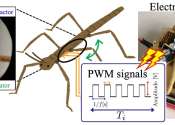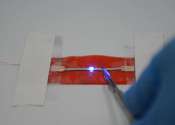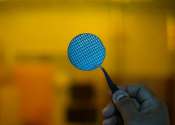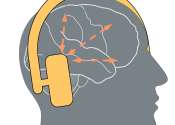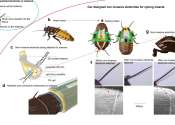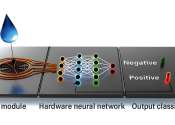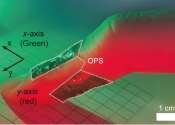Electronics & Semiconductors news
Electronics & Semiconductors
New approach reliably integrates 2D semiconductors with dielectrics
Two-dimensional (2D) semiconductor materials could enable the development of smaller yet highly performing electronic components, thus contributing to the advancement of a variety of devices. While significant strides have ...
Apr 4, 2025
0
26
Electronics & Semiconductors
Intel, TSMC reach preliminary chipmaking deal: report
Intel and Taiwan Semiconductor Manufacturing Co (TSMC) have reached a preliminary agreement to form a joint venture to operate Intel's chipmaking facilities, tech news outlet The Information reported on Thursday.
Apr 4, 2025
0
0

Programmable pixels could advance infrared light applications
Without the ability to control infrared light waves, autonomous vehicles wouldn't be able to quickly map their environment and keep "eyes" on the cars and pedestrians around them; augmented reality couldn't display realistic ...
Mar 31, 2025
0
39

Organic solar cells face efficiency challenge due to slow current flow, researchers show
Researchers from the Chair of Optics and Photonics of Condensed Matter led by Prof. Dr. Carsten Deibel at the Chemnitz University of Technology and other partner institutions are currently working on solar cells made from ...
Mar 31, 2025
0
3

Japan to pour additional $5.4 bn into chipmaker Rapidus
Japan said Monday it had decided to inject more than $5 billion extra into semiconductor venture Rapidus, which is aiming to mass-produce next-generation chips in the country from 2027.
Mar 31, 2025
0
1
Electronics & Semiconductors
DNA scaffolds enable self-assembling 3D electronic devices
Researchers at Columbia Engineering have for the first time used DNA to help create 3D electronically operational devices with nanometer-size features.
Mar 29, 2025
0
40
Electronics & Semiconductors
Advancing semiconductor devices for AI: Single transistor acts like neuron and synapse
Researchers from the National University of Singapore (NUS) have demonstrated that a single, standard silicon transistor, the fundamental building block of microchips used in computers, smartphones and almost every electronic ...
Mar 28, 2025
0
47
Electronics & Semiconductors

A lighter, smarter magnetoreceptive electronic skin
Imagine navigating a virtual reality with contact lenses or operating your smartphone underwater: This and more could soon be a reality thanks to innovative e-skins.
Mar 27, 2025
0
59
Electronics & Semiconductors

Smart textiles and surfaces: How lightweight elastomer films are bringing tech to life
A research team led by Professors Stefan Seelecke and Paul Motzki from Saarland University is using a highly versatile film not much thicker than household cling film to impart new capabilities to objects while saving energy ...
Mar 27, 2025
0
17
Business

China chip insiders eye stronger global ties despite trade tensions
Industry insiders at a semiconductor trade fair in Shanghai urged more cooperation between the Chinese chip sector and the rest of the world, despite growing trade tensions with Washington.
Mar 26, 2025
0
1
Electronics & Semiconductors

Shape-shifting OLED panel: Dynamic smartphone display with integrated speaker technology unveiled
A research team has developed the world's first smartphone-type OLED panel that can freely transform its shape while simultaneously functioning as a speaker—all without sacrificing its ultra-thin, flexible properties.
Mar 25, 2025
0
31
Electronics & Semiconductors

Artificial nerve with organic transistor design shows promise for brain-machine interfaces
In recent years, many engineers have been trying to develop hardware components that could emulate the functions of various biological systems, including synapses, the human skin and nerves. These bio-inspired systems include ...
Electronics & Semiconductors

Harnessing nature's fractals for flexible electronics: Biomimetic fabrication technique uses leaf skeletons as templates
By using leaf skeletons as templates, researchers harnessed nature's intrinsic hierarchical fractal structures to improve the performance of flexible electronic devices. Wearable sensors and electronic skins are examples ...
Mar 24, 2025
0
24
Electronics & Semiconductors

Using perovskite to make LED pixels as small as a virus
A team of physicists, engineers, opticians and photonics specialists at Zhejiang University, in China, working with a pair of colleagues from the University of Cambridge, in the U.K., has found a way to make pixels smaller ...
Electronics & Semiconductors

Novel memristors to overcome AI's 'catastrophic forgetting'
So-called "memristors" consume extremely little power and behave similarly to brain cells. Researchers from Jülich, led by Ilia Valov, have now introduced novel memristive components that offer significant advantages over ...
Mar 20, 2025
0
47
Electronics & Semiconductors

Electromechanical building blocks enable rapid prototyping of large interactive structures
Prototyping large structures with integrated electronics, like a chair that can monitor someone's sitting posture, is typically a laborious and wasteful process.
Mar 18, 2025
0
58
Electronics & Semiconductors

Heat-based stabilization of a conductive polymer simplifies bioelectronics fabrication
Recent advances in the field of materials science have opened new possibilities for the fabrication of bioelectronics, devices designed to be worn or implanted in the human body. Bioelectronics can help to track or support ...
Electronics & Semiconductors

A tiny component for record-breaking bandwidth: New modulator breaks the terahertz mark
Plasmonic modulators are tiny components that convert electrical signals into optical signals in order to transport them through optical fibers. A modulator of this kind had never managed to transmit data at a frequency of ...
Mar 13, 2025
0
45
Electronics & Semiconductors

Multifunctional solar cells: Ferroelectric domain manipulation enhances electric output in perovskite crystals
A team of researchers has made an advancement in the field of multifunctional energy harvesting. Their latest study advances in understanding the photovoltaic effect in ferroelectric crystals.
Mar 13, 2025
0
59
Business

Intel hires former board member as new CEO in struggling chipmaker's latest comeback attempt
Struggling chipmaker Intel has hired former board member and semiconductor industry veteran Lip-Bu Tan as the latest in a succession of CEOs to attempt to turn around a once-dominant company that helped define Silicon Valley.
Mar 13, 2025
0
0
Electronics & Semiconductors

Ultra-broadband photonic chip boosts optical signals to reshape high-speed data transmission
Modern communication networks rely on optical signals to transfer vast amounts of data. But just like a weak radio signal, these optical signals need to be amplified to travel long distances without losing information.
Mar 12, 2025
0
25
Electronics & Semiconductors

High-performance programmable photonic chip could transform radar and communication systems
Researchers at the University of Twente, in collaboration with the City University of Hong Kong, have designed a cutting-edge programmable photonic chip in a thin-film lithium niobate platform, an important material in photonics. ...
Mar 11, 2025
0
57
Electronics & Semiconductors

Cheap and environmentally friendly—the next generation of LEDs may soon be here
Cost, technical performance and environmental impact—these are the three most important aspects for a new type of LED technology to have a broad commercial impact on society. This has been demonstrated by researchers at ...
Mar 11, 2025
0
67
Electronics & Semiconductors

A new on-chip microcomb to synchronize signals in optoelectronics
Optoelectronics are promising devices that combine optical components, which operate leveraging light, with electronics, which leverage electrical current. Optoelectronic systems could transmit data faster than conventional ...
Electronics & Semiconductors

Hydrogen sensor that could pave the way for safer, cleaner energy
Scientists have developed a hydrogen sensor that could accelerate the transition to clean hydrogen energy. As the world transitions away from fossil fuels, hydrogen is considered a key player to the transition to cleaner ...
Mar 6, 2025
0
47




















